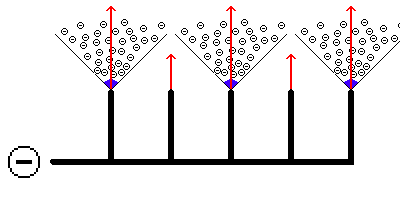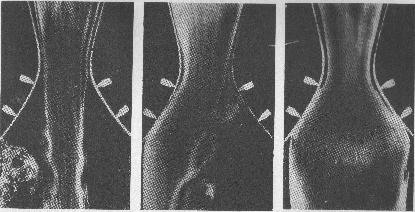
|
Author's experiments |
|
|
1 - Purely electric instabilities

As seen in Corona Glow introduction a glow at atmospheric pressure is in general instable, it can be stable only for glows of very small dimensions in presence of a high gradient of the field. Even in this case, the stability is obtained only for sufficient intensities. Below a certain critical value of the current exist a pulsed regime (relaxation regime) were frequencies up to the megahertz can be observed.

If the strained electrode is not sharp enough, the glow can oscillate between several positions, sometimes at very low frequencies (observable with bare eyes).

In some cases, the circulation of the glow around a smooth point can look like a crown. It is probably the reason why this sort of glow has been called Corona Glow.
Moreover, if the source has a certain extension in space (wires, blades...) one may observe position instability or quantification in space.

In negative corona for example if the source is composed of a series of aligned points, if the points are too close, only one over two lights. A small exterior perturbation can produce an overall swing.

Although this electrical instability is to my knowledge not really understood, it seems to be a sort of influence phenomenon. The space charge creates a field reduction in the regions that are not protected by the plasma screen. In these regions, the field is maintained below the threshold and the glow cannot light there.

If this qualitative explanation is correct, more experimentation is needed and a quantitative model (theory) remains to be developed.
2 - Purely fluid instabilities
The existence of viscosity forces in fluids generates hydrodynamics instabilities. In fact instabilities appear when the viscosity forces are small compared with inertia forces, so it is more realistic to say that inertia forces generate instabilities and that viscosity dumps it. A paradox in hydrodynamic is then that a perfect non-viscous fluid should be infinitely turbulent. In fact, when the inertia increased versus viscosity the fluid become more turbulent but the quantitative effect of turbulence decreased as the ratio of forces excepted in a small region near the walls called the boundary layer. It is the boundary layer theory (see the Mc GRAW HILL book in references ) that permit to compute effects such as drag, stalling...This theory is not simple and many aspects (such as transition to chaos) although well described by experiments (or computations) are still looking for a model better than the statistical model of Prandtl for turbulence witch is correct only when the turbulence is fully developed. One thing is clear from the theory is that a very little action in the boundary layer can have a drastic effect on all the flow (for the worst or the better).

The suction on the boundary layer modify drastically the whole flow
The corona wind leads in general to situations near the transition and so are very difficult to manage but at the same time, because of their small size, can have decisive interaction with the boundary layer. If it seem to me clear that a drag reduction effect is highly probable (but remain to be proved) in certain simple cases, it is not certain that it will be applicable to normal size engines were several cells will have to be aligned in the flow (see drag reduction page).
This instability was first observed in high voltage transformer oil, it has been well described and studied by the Felici Lab in Grenoble. This instability manifest itself by the appearance, in the case of a fluid submitted to an homogenous force, of alleys of vortices (when the injected current is over a certain threshold ) and lead for higher currents to the usual transition to chaos. The particularity of the E.H.D. instability is that the equations obtained are similar to those of the Rayleigh-Benard instability (fluid warmed by the bottom) that you encountered each time you boiled some water in a can. The advantage of E.H.D. instability is that the current injection is easier to control that the heat injection in the Rayleigh-Benard problem and is then a nice tool to study the transition toward turbulence.

Rayleigh-Benard instability
E.H.D. instability can be considered as usual viscous fluid instability were the inertia term (fluid movement) is produced by the effect of electrical forces.